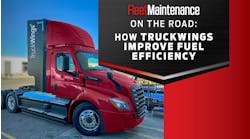At Work Truck 2020, Ford announced a battery-electric version of the Transit, the best-selling van in the world, will be available for model year 2022. The OEM has invested more than $11.5 billion into electrification, previously revealing plans to offer electric and hybrid options for the F-150 pickup truck, as well as the battery-powered Mustang Mach-E crossover SUV.
“We are playing to our strengths, the things that brought us to the party: pickups, vans, performance vehicles, utilities. This is what we know best, this is where our loyal customers are, and this is where we really can make great vehicles for our customers,” said Ted Cannis, global director of electrification at Ford.
The electric Transit will not be one size fits all, with cargo, cutaway and chassis cabs available, with three different roof heights from which to choose. And while gas and diesel options are still options, Cannis could only laud the benefits of the zero-emissions van.
He cited a U.S. Department of Energy statistic stating that charging an electric vehicle can be less than half that of fueling an internal combustion engine, depending on an area’s power rates.
Cannis also noted more reliable uptime due to less frequent maintenance, as there are less parts to service, no oil or transmission fluid changes, and no need to stop at a gas station.Like all new models, these U.S.-built vans will come equipped with the FordPass Connect on-board modem to provide diagnostic and location data.
“Our Ford commercial solutions team is going to bring to light all the data and all the telematics to help fleet managers manage their business in a way that they've never been able to do,” said Mark Buzzell, director of Ford North American fleet, lease and remarketing operations. “It's making them more efficient, improving total cost of ownership, and going after that 100 percent uptime goal that we're all working towards.”
Ford’s push for electric is a response to fleets needing to meet corporate responsibility goals, such as one fleet expressing a mandate to cut down CO2 emissions by 25 percent in the next five years or another targeting carbon neutrality by 2035.
These vans will also address the demands of end customers who expect the brands and companies last mile or service fleets represent to reduce their carbon footprint, while still being able to make daily ecommerce drops to their doorstep.
“Seventy-eight percent of adults globally are looking to have their companies and their activities improve the global climate solutions,” Cannis said. “And so you're seeing that ripple through the whole system; there is tremendous demand for change.”
How to keep battery electric vehicles powered up remains an issue in many regions, so Ford plans to construct “the largest charging network in North America,” adding 12,500 electric fueling stations.
Cannis noted that while potential users question BEVs’ ability to work in cold weather (due to shortened battery life) or power, these new electric and hybrid models will not lack in what made them best sellers.
“It will not be a compromised product,” he said of the upcoming F-150 hybrid. “It will be an ‘and’ product— great fuel efficiency, great torque and new capabilities never had before, like an onboard generator to power up the work site.”





